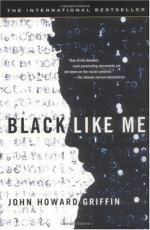|
This section contains 822 words (approx. 3 pages at 400 words per page) |

|
Black Like Me Summary & Study Guide Description
Black Like Me Summary & Study Guide includes comprehensive information and analysis to help you understand the book. This study guide contains the following sections:
This detailed literature summary also contains Topics for Discussion and a Free Quiz on Black Like Me by John Howard Griffin.
Black Like Me by John Howard Griffin was published in 1960 at the beginning of the Civil Rights movement. John Howard Griffin, a white man from Mansfield, Texas, decides to take a tour through the Southern United States as a black man. Griffin writes all of his experiences and thoughts down in his journal. He does not fail to detail every single experience that he has or any person that he meets. In order to keep many people safe, Griffin does not use names or let many people in on his plan. By becoming a black man, Griffin sees first hand what it is like to be a black person dealing with racism in the South.
The book begins with Griffin looking at statistics on the suicide rates of blacks in the South. The rates seemed to be rising. Griffin thinks that this is not suicide, but blacks giving up on their ability to live as their situation seems so bleak. He decides that the only way to know is to become a black man. Griffin goes to his friends at Sepia, a black magazine, and asks for their mental and financial support for the project. They agree to fund his trip as long as they may also publish portions of the book in their magazine. After consulting them, Griffin tells his wife of the plan. While she is not thrilled, she feels Griffin must take on the project if he feels he must. Griffin begins his trip in New Orleans.
After arriving in New Orleans, Griffin goes to a doctor to see about darkening his skin. He and the doctor develop the best method. After taking oral medication and sitting under UV lights, Griffin's skin turns a dark brown color. While the doctor was thrilled to help him at first, he later has second thoughts about the experiment. Griffin dismisses the doctor's protestations. He goes out into the city and is shocked by his new appearance. He is also startled by all the things that he is limited to do. He can longer eat, use the bathroom, or shop where he wants. By becoming black, Griffin realizes he is now a second class citizen.
In New Orleans, Griffin meets Sterling Williams. He first meets Sterling as a white man and then meets him as a black man. He lets Sterling in on the secret. Griffin is shocked by the difference in Sterling's conversation with him. Sterling talks to Griffin with more openness and brotherhood when he is a black man. Griffin also meets black leaders and talks with them about how to make blacks' lives better. Griffin enjoys the intellectual discussions but is almost found out when one of the men insists he has read some of Griffin's work. Griffin also continues to visit Sterling while he looks for a job. While with Sterling, Griffin finds out about the lynching of a black man, Mack Parker, in Mississippi. The mob who lynched Parker was not found guilty, even though there was enough evidence against them. Griffin decides that he must go to Mississippi to see what it is like.
Griffin next travels through Biloxi and Hattiesburg in Mississippi. Here Griffin encounters more racism than he did in New Orleans. To his face, whites in New Orleans were very courteous. They hid their contempt. In Mississippi, however, the hate and racism is blatant. Griffin experiences hate stares from many white women as well as many white men threatening him if he steps out of line.
After Mississippi, Griffin goes to Mobile and Montgomery. In these two places, Griffin becomes so depressed and lonely that he begins to hate being trapped in the skin of a black man. He cannot bare not recognizing himself and constantly being judged by the color of his skin. Griffin realizes that no matter his education or personality, he has no opportunities. From then on, Griffin decides to "zigzag" between being black and white. He then goes to Georgia where he is excited and happy about the atmosphere there. Due to the leadership of Martin Luther King, the blacks have a sense of determination there. This gives Griffin some confidence about the future.
The novel ends with Griffin publishing his journal and notes as a book. Many people are thrilled about the book and as a result Griffin is asked to be interviewed by award winning newspapers and popular television programs. Although many accepted the book, Griffin and his family are threatened by racist southern whites. Griffin's parents are ignored in town and receive hate phone calls, while Griffin's effigy is hung in his hometown. Griffin decides to move his family out of Mansfield, because he does not want to risk their safety. Yet Griffin knew that this might happen. He is still happy that the book has helped to open so many people's eyes and minds to the situation of blacks in the South.
Read more from the Study Guide
|
This section contains 822 words (approx. 3 pages at 400 words per page) |

|



